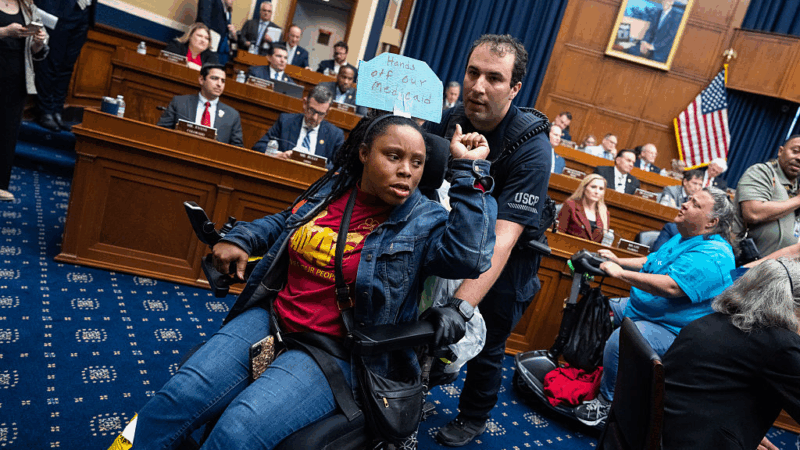New studies show what’s at stake if Medicaid is scaled back
Two research studies published this month add important data to the fierce political debate over Medicaid in Washington, D.C.Each study — one published last week in the New England Journal of Medicine, and the other released as a working paper from the nonpartisan National Bureau of Economic Research — offers evidence that Medicaid, the public insurance program that covers more than 70 million low-income and disabled Americans, is saving people’s lives.
As Congress considers major changes to the program, these findings underscore the importance of treading carefully, said Harvard University economist Amitabh Chandra, who was not involved in either study.
“What we’re learning is that restricting access to Medicaid might save us money, but that comes at a tremendous cost,” said Chandra. “And that cost is human lives.”
Tens of thousands of lives saved
The National Bureau of Economic Research paper, by Angela Wyse, an economist at Dartmouth College, and Bruce Meyer, a University of Chicago economist, focused on the millions of low-income adults who gained Medicaid coverage in states that expanded the program under the Affordable Care Act. After examining a dataset of 37 million people, the authors found:
- People who gained Medicaid coverage via the ACA expansion were 21% less likely to die in a given year of enrollment than peers who did not get the health coverage.
- States that chose to expand Medicaid saved 27,400 lives between 2010 and 2022.
- States that declined to expand Medicaid in 2014 missed the chance to save 12,800 more lives.
The study does not explain how Medicaid expansion had this effect, but prior research has shown the program is linked with improved physical health and reductions in deaths from diseases like diabetes and cancer.
Wyse and Meyer also found that younger adults, who many have long assumed have less to gain from insurance, saw strong life-saving effects from the program, too. The authors suggest that coverage of mental health and substance use treatment for this age group could be key.
Medicaid brings life-saving drugs within reach
The NEJM study, published May 14, examined Medicaid’s effects on a smaller, yet especially vulnerable group of people who are eligible for both Medicare and Medicaid.
These 12 million Americans have low incomes and are also either disabled or over age 65, with some checking all three boxes. To get the care they need, this group of “duals,” as they’re often called by policymakers, are forced to navigate both of the country’s largest public health insurance programs.
When duals lose their Medicaid they also lose vital Medicare coverage that lowers prescription drug costs (the Part D Low-Income Subsidy) by roughly $6,000 a year on average. However, due to a quirk in policy, some people are able to keep this subsidy longer than others, depending on when in the year they lose their Medicaid.
The study’s authors, led by University of Pennsylvania economist Eric Roberts and Harvard researcher José Figueroa, took advantage of this disenrollment quirk to isolate and measure the Part D Low-Income Subsidy’s effects. They found that compared to patients who kept this extra help for longer, those who lost it sooner:
- Filled 1.2 fewer prescriptions on average
- Were between 4% and 22% more likely to die, depending on their level of medication costs and types of medicines used
- Were most likely to die during the 17-month study period if they had especially high drug costs
- Were more likely to die in that period if they’d been relying on medicines to manage HIV, heart disease or chronic lung disease
Chandra, the Harvard economist, said that in addition to showing the value of Medicaid, this “remarkable paper” helps answer a much larger question.
“It’s great that we now know Medicaid saves lives, but there’s still been this question about why,” said Chandra. “Why does Medicaid cause people to live longer?”
One clear reason, at least according to this paper, he said, is that the program makes prescription drugs easier to get. And that, said Chandra, is a testament to the value of not only Medicaid, but also medication access more broadly.
A regulation from the Department of Health and Human Services that was finalized in 2023 was poised to help nearly 1 million more duals gain this extra medication assistance. But the latest Republican proposal delays that rule until 2035.
The impact of extra red tape
Roberts, the study’s coauthor, highlighted one other timely implication of his team’s results.
Citing concerns about waste and fraud, Republicans are proposing increased frequency of eligibility checks as well as requiring states to put in place work requirements — both of these could make it harder for people to stay on Medicaid.
Research shows it’s common for people to briefly lose Medicaid coverage (as their income fluctuates, for example, or because of paperwork errors) but regain it soon thereafter — a phenomenon known as “churn.”
Policies that increase churn could have deadly effects, according to Roberts.
“For very sick, very poor people, even going one week without life-saving drugs can have huge consequences,” he said.
Roberts found that nearly 3,000 duals died despite many of those people only losing their drug subsidy for about two extra months.
Together, the two research papers highlight a tough reality for congressional Republicans as they continue to consider a slate of possible Medicaid cuts to fund their other policy priorities.
No matter how they shrink the program, whether by making federal funding less generous or paperwork more onerous, this new evidence suggests that some people are likely to get hurt.
This story comes from the nonprofit health news organization Tradeoffs and originally appeared on its website. Leslie Walker is a senior reporter/producer for Tradeoffs.
‘Bomb cyclone’ forecasted to bring heavy snow, blizzard conditions and dangerous travel
A 'bomb cyclone' is intensifying severe winter weather for millions of people across the U.S. The system is expected to knock out power and disrupt holiday travel.
Russia sends 3 Iranian satellites into orbit, report says
The report said that a Russian rocket sent the satellites on Sunday from a launchpad in eastern Russia.
Viral global TikToks: A twist on soccer, Tanzania’s Charlie Chaplin, hope in Gaza
TikToks are everywhere (well, except countries like Australia and India, where they've been banned.) We talk to the creators of some of the year's most popular reels from the Global South.
This painting is missing. Do you have it?
An important work from a rediscovered artist has been absent from public view since the 1970s. A New York curator is hunting for it.
Memory loss: As AI gobbles up chips, prices for devices may rise
Demand for memory chips currently exceeds supply and there's very little chance of that changing any time soon. More chips for AI means less available for other products such as computers and phones and that could drive up those prices too.
Brigitte Bardot, sex goddess of cinema, has died
Legendary screen siren and animal rights activist Brigitte Bardot has died at age 91. The alluring former model starred in numerous movies, often playing the highly sexualized love interest.








